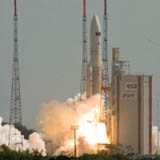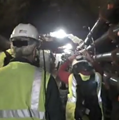


An Ariane 5 rocket carried the Planck satellite and a companion satellite into space Thursday morning from the European Space Agency (ESA) base on the northeast coast of South America. Once in orbit beyond the moon, Planck will produce the most accurate measurements ever made of the relic radiation from the big bang, plus the largest set of CMB data ever recorded. Berkeley Lab’s long and continuing involvement with Planck began when George Smoot of the Lab's Physics Division proposed Planck’s progenitor to ESA and continues with preparations for ongoing data analysis for the U.S. Planck team at NERSC, led by Julian Borrill, co-leader of the Computational Cosmology Center. More>
 In The News: Critical Milestone Reached at Sanford Underground Lab
In The News: Critical Milestone Reached at Sanford Underground Lab [Rapid City Journal] Officials at the Sanford underground laboratory at Homestake moved a big step closer to actual underground science experiments in Lead on Wednesday when crews cleared water from the 4,850-foot level. Kevin Lesko, a physicist at Berkeley Lab, is leading a team of scientists and engineers designing the even deeper Deep Underground Science and Engineering Lab (DUSEL). He called regaining access to the 4,850 a "critical milestone." More>
 The Women Scientists' Council Luncheon Seminar is scheduled for today in Perseverance Hall (Bldg. 54-130) from 11:30 a.m. to 1 p.m. The guest speaker is Eva Nogales, a Faculty Scientist in the Life Sciences Division. Nogales's Lab researches the structural characterization of complex biological assemblies, their architecture, conformational flexibility, and their interactions with ligands and cellular partners. Go here for more on her research.
The Women Scientists' Council Luncheon Seminar is scheduled for today in Perseverance Hall (Bldg. 54-130) from 11:30 a.m. to 1 p.m. The guest speaker is Eva Nogales, a Faculty Scientist in the Life Sciences Division. Nogales's Lab researches the structural characterization of complex biological assemblies, their architecture, conformational flexibility, and their interactions with ligands and cellular partners. Go here for more on her research.
 World of Science: Chu Comments on Yucca Mountain, Hydrogen Fuel Cells
World of Science: Chu Comments on Yucca Mountain, Hydrogen Fuel Cells Technology Review's energy editor sat down to talk with Energy Secretary Steve Chu about two of the most controversial decisions of the first hundred days: the proposed elimination of funding for nuclear waste storage at Yucca Mountain and the budget cuts to hydrogen fuel cell research. A researcher at heart, Chu discussed some of the technical solutions to storing nuclear waste and applications for fuel cells that might be more practical than using them to power cars. More>
As part of a geological investigation, drilling will take place in four different locations at the Lab, affecting parking and traffic in those areas. The first drilling will take place May 18 and 19 on the south side of Building 25. The second and third will occur on the south side of Building 25 between May 19 and 21. The third drilling site will require the road between Buildings 4 and 25, which is normally one-way going north, to be redirected one-way south during this time. The fourth location is the south side of Building 48, with drilling between May 21 and 27. Contact Sheree Swanson (510-220-5430) or Tim Kemper (925-250-9351) for more information.
Berkeley Lab prohibits discrimination against or harassment of any person employed or seeking employment with the Laboratory on the basis of race, color, national origin, religion, sex, gender identity, pregnancy, physical or mental disability, medical condition (cancer-related or genetic characteristics), ancestry, marital status, age, sexual orientation, citizenship, or service in the uniformed services (as defined by the Uniformed Services Employment and Reemployment Rights Act of 1994). More>
Today at Berkeley Lab is produced by Public Affairs' Communications Department